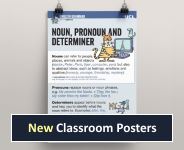Explanation
A function label for an element in the clause which typically comes after the verb phrase and identifies the person or thing that undergoes the situation described by the main verb. For example, in Greg stroked the dog, the function of Direct Object is filled by the dog. See also Object, which is the term preferred in the National Curriculum.Englicious contains many resources for English language in schools, but the vast majority of them require you to register and log in first. For more information, see What is Englicious?

